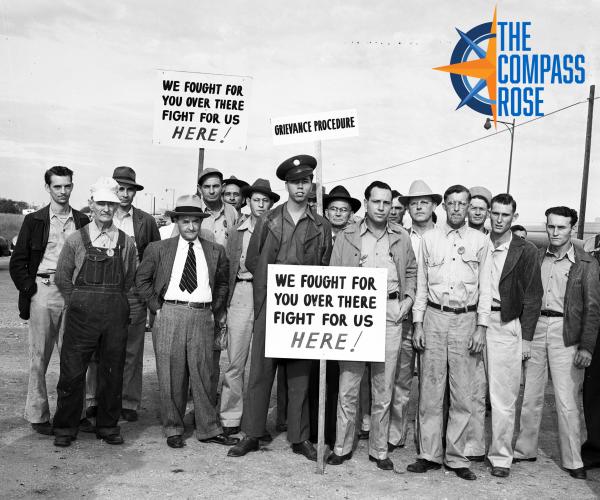
by Michael Barera


by Michael Barera
The purpose of The Compass Rose is to raise awareness of Special Collections' resources and to foster the use of these resources. The blog series also reports significant new programs, initiatives, and acquisitions of Special Collections.
On February 25, 1946, 4,000 workers at the Consolidated Vultee (Convair) Aircraft plant in Fort Worth began striking (Dallas Morning News 1946d) (Botter 1946). The major cause of the strike was a disagreement between Convair and International Association of Machinists (IAM) Local 776 over a new contract. The union accused the company of failing to negotiate in good faith and then filed charges with the National Labor Relations Board (NLRB). According to Convair division manager R. G. Mayer, the strike initially reduced productivity at the plant by 35%, but according to IAM Local 776 president John F. Foster, Jr., it “virtually stopped” production (Botter 1946). Despite some hope of an early resolution, no such event occurred in the first week of the deadlock (Dallas Morning News 1946a).
In early April, five people were injured after fighting broke out between picketing strikers and workers who crossed the picket line. The fights occurred shortly after District Judge Walter H. Morris issued a temporary restraining injunction against the IAM. Three people, two picketers and one worker crossing the picket lines, were arrested and two were charged with affray while the other was charged for using abusive language. At its peak, the disturbance completely shut down the highway running alongside the plant (Dallas Morning News 1946b).
In early May, 31 picketers were arrested and charged with unlawful assembly after they blocked the loading docks at the plant. They were attempting to prevent the delivery of a large piece of equipment arriving via the Texas and Pacific Railway. All those arrested were released on bond within two hours, but Foster, Jr., was “forcibly carried to the patrol wagon by policemen” during the incident (Dallas Morning News 1946c).
On May 17, a stipulation of agreement between the IAM and Convair was signed, although the details of the agreement were not immediately made public. It went directly to the IAM members for their approval (Dallas Morning News 1946d). The following day, May 18, the contract was signed, ending the strike after 84 days. The new one-year contract included a 15% wage increase agreed to by Convair and the IAM, which was half of the union’s initial request for a 30% increase (Dallas Morning News 1946e).
The 1946 Convair strike in Fort Worth was part of the national strike wave of 1945-46, which in the words of Melvyn Dubofsky was “the most strike-prone period in U.S. history” (Dubofsky 1995). In 1946 alone, there were 5,000 strikes involving 4.6 million workers nationwide, which accounted for over 10% of all employed workers in the country (Dubofsky 1995). There were also other major strikes in Texas during this period, including those involving telephone workers and public employees in Houston and workers at the General Tire and Rubber plant in Waco (Green 1990).
Robert G. Rodden observed that during 1945-46, “labor and management slugged it out across picket lines in almost every industry” (Rodden 1984 pp. 144-45). Rodden attributed the wave of strikes to multiple factors, including the pent-up grievances of union members that were not addressed during World War II, long working hours, and the failure of wages to keep up with cost of living. He also noted that the IAM paid over $200,000 in strike benefits to its members during strikes at Convair plants in both Fort Worth and San Diego (Rodden 1984 p. 145).
Botter, David. 1946. “Strike Hits Fort Worth Plane Plant.” Dallas Morning News, February 26, 1946.
Dallas Morning News. 1946a. “Police Fight Pickets at GE Factory,” February 28, 1946.
———. 1946b. “5 Injured in Fights Around Strikebound Plant in Fort Worth,” April 9, 1946.
———. 1946c. “31 Pickets Arrested at Fort Worth Plant,” May 11, 1946.
———. 1946d. “Agreement up in Convair Labor Strife,” May 18, 1946.
———. 1946e. “Convair Strikers Accept Contract,” May 19, 1946.
Dubofsky, Melvyn. 1995. “Labor Unrest in the United States, 1906-90.” Review (Fernand Braudel Center) 18 (1): 125–35.
Green, George. 1990. The Labor Story. Texas AFL-CIO.
Rodden, Robert G. 1984. The Fighting Machinists: A Century of Struggle. Washington, D.C.: Kelly Press, Inc.
Add new comment